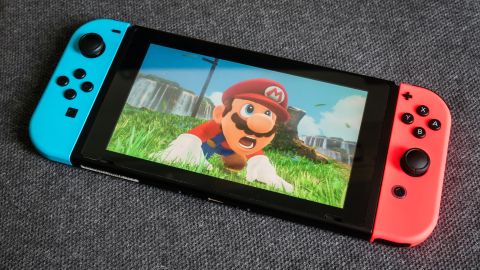TechRadar Verdict
The Nintendo Switch is one-part handheld and one-part home console, and hopes to be the only device you'll ever need for gaming, wherever you are. The hybrid console is an undeniable success, offering up an exceptional level of handheld graphical quality, while seamlessly transitioning into a home console – though this very adaptability has required compromises on power and functionality compared to the dedicated consoles and handhelds that came before it.
Pros
- +
Unique hybrid design
- +
HD Rumble
- +
Two controllers included
- +
Bright, crisp, colorful screen
Cons
- -
Joy-Con charge on console only
- -
Split D-pad
- -
Oddly placed right analogue stick
Why you can trust TechRadar
The Nintendo Switch is the first step toward bridging the gap between home and handheld consoles, so it’s an incredibly significant addition to Nintendo’s family of consoles in terms of its unique offering. It boasts a tonne of shiny new features to build upon the foundations set by previous consoles and packs some impressive capabilities in its hybrid form, especially when you take its flexibility into account.
Seven years on, following a 2019 revision of the console and the more recent arrival of the Nintendo Switch OLED and Nintendo Switch Lite models, the Nintendo Switch is more popular than it's ever been, and it's apparent Nintendo has struck a winning formula with its handheld hybrid.
The design of the Nintendo Switch has helped Nintendo to continue its high reign in the console space with something entirely unique, especially running off the back of the innovative Nintendo Wii and beloved Nintendo 3DS.
The Switch is a significantly different device from what we've seen prior, and the handheld nature of the console provides the best of both worlds. As the list of best Nintendo Switch games gets bigger with high-quality first-party games and unique third-party offerings, you'll more than likely want to sink hours into the console whenever you can.
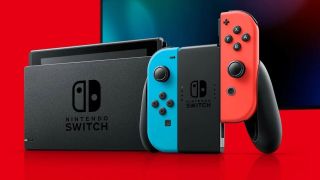
Whether you've already made your purchase or not, it's hard to deny that the Nintendo Switch is a fine idea, mixing some of what made the Wii and Wii U appealing for gamers (even if developers had a more challenging time figuring out how to make the most of the latter device).
The Nintendo Switch brings with it a central idea that can benefit literally every game, not just the select few that can use motion control or a second screen. Who hasn't at one time wanted to pack up their console and take it with them? Essentially, the Switch delivers on this hybrid idea. You'll find it a solid, premium handheld that can flip into docked mode and work as you'd expect a home console.
At the same time, the Nintendo Switch certainly isn't perfect: most of the issues it has are a consequence of the way that it dares to try and do everything at once, and it doesn't always get the compromise right.
Those who aren't sold on its hybridity and want that classic Nintendo handheld experience will no doubt be interesting in the compact, lighter alternative: the Nintendo Switch Lite, which offers a solely handheld Switch gaming experience. For those after something more premium, there's also the Nintendo Switch OLED, which mainly improves the portable aspect of play.
Nintendo Switch: price and release date
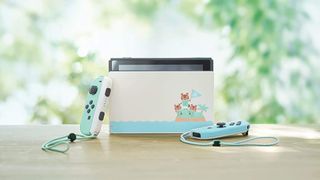
- What is it? Nintendo's hybrid console
- When did it come out? March 3, 2017
- What does it cost? $259.99 / £259.99 / AUD$435
The original Nintendo Switch launched on March 3, 2017. While it previously cost $299.99 in the US, £259.99 in the UK, and $469.95 in Australia, Nintendo gave the base model a small price cut after the Switch OLED model arrived October 2021. Nowadays, you'll find it going for €269.99 / £259.99 / $259.99 / AU$435.
Nintendo Switch: design
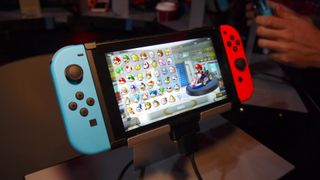
- Three form factors: handheld, console (docked) and tabletop
- Lots of accessories, which are at risk of being misplaced
In the box with your shiny new Nintendo Switch, you get the main console, two detachable controller sides (Joy-Cons), a grip which enables you to combine these controller portions into a more traditional gamepad, two straps which can make them into two individual controllers, and a dock for plugging the console into your television.
You also get a USB Type-C power cable (with a non-detachable power brick) and an HDMI cable for connecting the device to your TV. If you think that sounds like a lot of accessories, then you'd be right: we suspect many Nintendo Switch owners will have misplaced at least one or two of these within a few months.
We've wrapped our Joy-Con straps around our Joy-Con grip just to keep everything together, but we'd love some way of attaching them to the console, so they don't end up getting misplaced. It's a pretty novel (not to mention somewhat complicated) setup, so it's worth delving into each of the different ways you can use the console.
Nintendo Switch: handheld mode
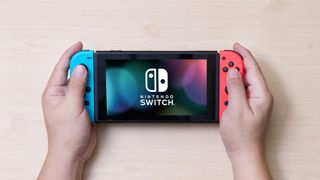
- Bigger than traditional handhelds
- Slightly cramped for the right hand due to right analogue stick
- Split D-pad on the left side
First in the Nintendo Switch modes is the handheld mode, the form factor most like the hardware devices that came before the Switch. In this configuration, you attach the two controller portions (the Joy-Cons) to the left and right edges of the screen, then game much as you can with the PlayStation Vita.
In fact, the size and shape of the console's analogue sticks make it feel a lot like a modern Vita, though it's not as solid because of the joints that exist between the Joy-Cons and the screen. Along the top of the Nintendo Switch is a slot for game cartridges, a headphone jack (Bluetooth headphones are now supported after a post-launch update), a volume rocker and a power button.
The bottom of the device is less busy. You've got the kickstand for tabletop mode (more on this later), which conceals a small microSD slot for expandable storage. Internal storage on the Nintendo Switch is limited to just 32GB, so if you're planning on downloading games rather than buying them, you'll want to invest in a Nintendo Switch SD card (capacities up to 2TB are theoretically supported).
Check out our unboxing video of the Nintendo Switch below.
The detachable Nintendo Switch Joy-Cons have a lot going on. The right-hand side has the classic A, B, X, and Y button configuration, an analogue stick (slightly awkwardly placed underneath the face buttons) and two shoulder buttons. A small plus-shaped button is the equivalent of the Wii U's 'Start' button and a home button for reaching the console's system-level menus.
Across on the left, Joy-Con, it's a very similar story, as you would expect. You've got a minus button that acts as the console's 'Select' button, a share button for taking screenshots and video (in selected titles), an analogue stick, two shoulder buttons, and the most un-Nintendo D-pad we've ever seen.
Instead of the classic cross D-pad Nintendo utilized since the NES, the left Joy-Con has a set of four circular buttons that are identical in shape to the face buttons on the right Joy-Con. This design decision, which appears very odd at first glance, is so the left Joy-Con can be used as an individual controller, with the D-pad acting as face-buttons in this configuration (again, more on this later).
Nintendo Switch: console mode
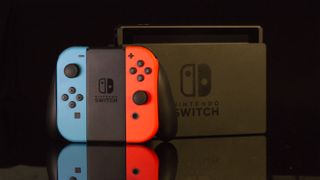
- Connects to your TV via an included dock
- Docking process is seamless, and can be done mid-game
The second Nintendo Switch form-factor is console mode. You place the main portion in the included dock, which connects the device to your television – you're then free to detach the Joy-Cons to control the Switch from a distance.
The way the console transfers the viewing experience from its own screen to the television is as seamless as it could possibly be, and you don't even have to pause your game. Everything happens in real-time. Detaching the Nintendo Switch Joy-Cons can be a little fiddly, admittedly: it's done by holding small buttons on their backs and sliding the controllers up.
The TV dock is roughly the same size as the Nintendo Switch's middle portion. Around the back, you've got a USB Type-C port to provide the console with power, an HDMI port to connect it to your television, and a USB Type-A port. On the left-hand side of the console are two additional USB ports, mainly used for charging your Switch controllers as you play wirelessly (more on this in a moment).
If you want to use the Nintendo Switch with multiple televisions throughout your home, you can buy additional Switch docks, which make it easy to transition from one screen to another, plug-and-play style. You can even use an OLED model's dock, which has a built-in Ethernet port.
Nintendo Switch: tabletop mode
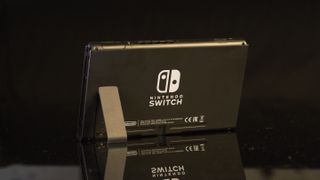
- Screen can also be detached and propped up on a table
- Great for two-player gaming, but four players on the console's small screen is a push
The final form factor for the Nintendo Switch is what Nintendo calls 'tabletop mode'. Using the kickstand attached to the back of the screen, you can prop the console up on a table and then detach the Joy-Cons for some semi-portable gaming. In theory, this is perfect for long journeys on public transport where you have a tray table to place the console on; in reality, we found it a bit of a mixed experience.
We do like being able to use the Nintendo Switch Joy-Cons in the grip rather than having them attached to the console – the grip provides just enough extra plastic to make the controllers much more comfortable in the hands, and having the console a little further away means your sitting posture can be a lot more natural.
Tabletop mode is also great for multiplayer on the Switch. Detaching both Joy-Cons to allow two people to play against one another is a pleasure: it makes the Nintendo Switch perfect for whipping out at small gatherings where you'll already have everything you need for a multiplayer session. However, a couple of issues prevent the console from fully capitalizing on this intriguing tabletop mode.
First is the kickstand. Although it's rubberized, which means that the Switch doesn't slide around, it only supports the console at a single height. If your tray table is a little closer to you, then there's no ability to prop the console up so that it's facing you more directly, and instead, you'll be stuck with the screen pointing at your chest rather than your face.
Second is the Nintendo Switch charging port, which is inaccessible when you use it in tabletop mode. During a recent train journey, this meant that although we were in the perfect situation to use tabletop mode, we ended up using the console as a handheld to charge it up.
Finally, the Nintendo Switch screen is just a little too small for multiplayer gaming for more than two players. Four-player Mario Kart is almost impossible due to the size and resolution of the display (we found ourselves putting our faces inches from the console to be able to make out distant details).
Overall, tabletop mode on the Switch feels better suited to short periods of use, which is a shame when it feels like it should be the de facto way to use the Nintendo Switch over long periods.
Nintendo Switch: set-up
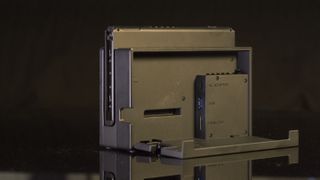
- Set-up is simple enough
- Console needs to be told whether Joy-Cons are being used together or separately
Setting up a brand new Nintendo Switch is refreshingly simple; you'll be pleased to learn. If you're using the device as a handheld, attach the Joy-Cons, press the power button, and... er... that's it.
If you want to play Nintendo Switch games on your TV, you need to plug the dock into the TV via HDMI, then hook it up to some power via the included USB Type-C power lead. The console then easily slips into the dock.
Pairing the controllers is a little more complicated than with other devices because of the fact that they can either be paired or used separately. The way you tell the Switch which controllers you're using is to press both the L and R shoulder buttons in whichever configuration you've opted for. So if you're using the Joy-Cons individually, you press the buttons on the Joy-Con straps to indicate this is the case.
On the software side, the console asks for the standard combination of Wi-Fi details and user account set-up info. These details are a doddle to input on the console's touchscreen – the keyboard isn't quite as good as a phone's, but it's much better than a typical console experience. Afterwards, games can be played off a cartridge or the Nintendo Switch's internal memory.
Nintendo Switch: recent updates
Nintendo has continued building upon the Switch since the Lite's launch. Alongside the launch of the Nintendo Switch Lite and Nintendo Switch OLED, it's also seen continued system updates.
Between reminding us to use our Nintendo Switch reward points and adding Nintendo Switch software folders to better organize our library of games, a Nintendo Switch Online achievements system also went live. Elsewhere, you can now add friends through the Nintendo Switch Online companion app, available on iOS and Android mobiles. It means adding friends is easier than ever on Nintendo Switch.
There’s no end of upcoming games to look forward to, but if you’re after the older classics, fear not. Thanks to the Nintendo Switch Online subscription service, there’s a continually growing library of NES and SNES games to play. If you’ve opted for the Expansion Pack, there’s Sega Genesis/Mega Drive and more N64 games are coming. We'd say keep your Nintendo Switch Online subscription for now.
Looking for advice on how to connect Nintendo Switch to your TV? After some recommendations for Nintendo Switch SD cards? We've got you covered.
Jon Porter is the ex-Home Technology Writer for TechRadar. He has also previously written for Practical Photoshop, Trusted Reviews, Inside Higher Ed, Al Bawaba, Gizmodo UK, Genetic Literacy Project, Via Satellite, Real Homes and Plant Services Magazine, and you can now find him writing for The Verge.
- Henry Stockdale
- Kara PhillipsEvergreen Writer
- Rhys WoodHardware Editor
- Dashiell WoodHardware Writer
Most Popular


